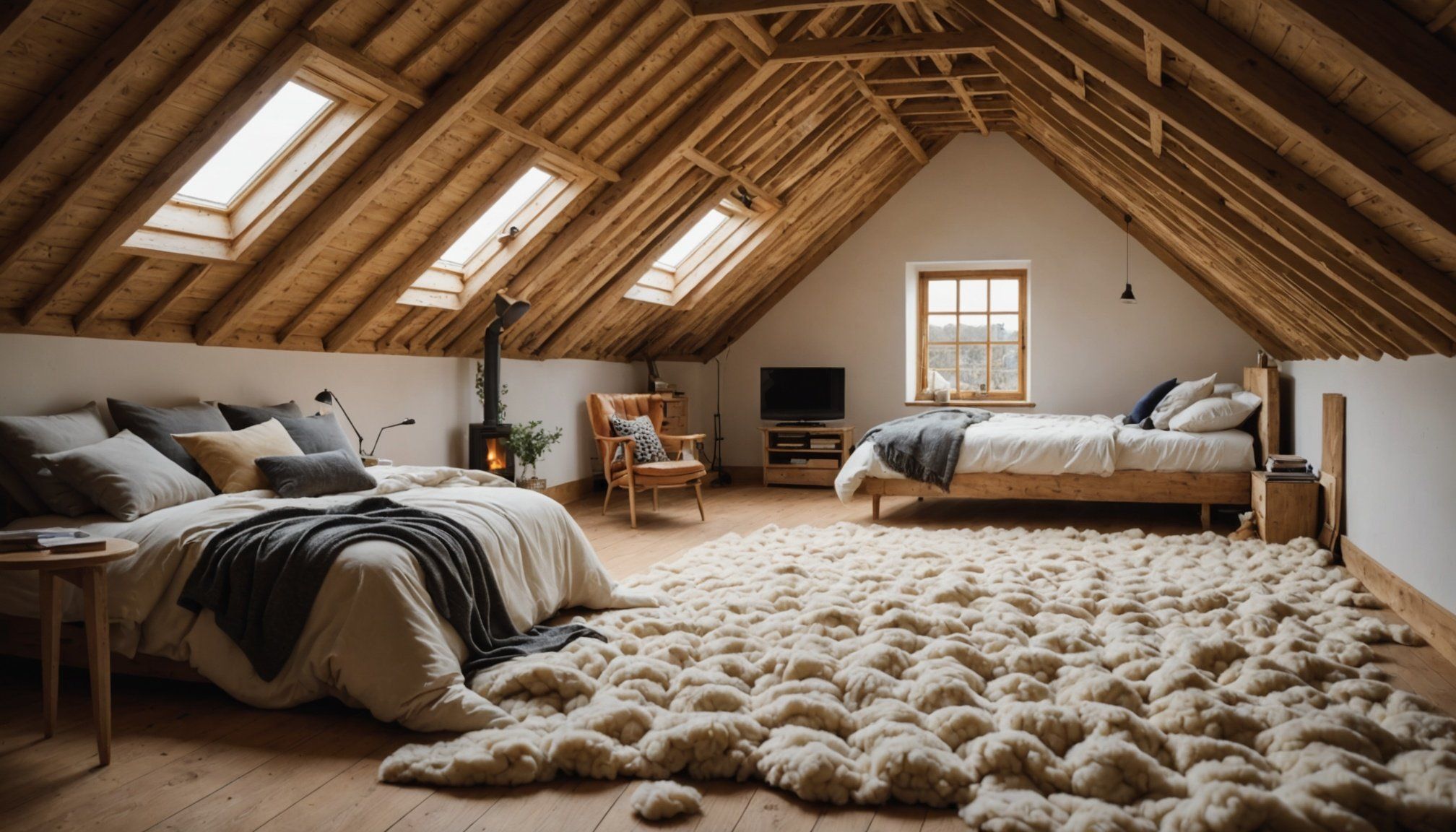Revamp Your Upgraded Loft: The Ultimate Guide to Eco-Friendly Wool Insulation
When it comes to upgrading your loft, one of the most critical aspects to consider is insulation. Not only does it enhance the energy efficiency of your home, but it also provides a comfortable and sustainable living space. In this guide, we will delve into the world of eco-friendly wool insulation, exploring its benefits, types, and how to install it in your loft.
What is Wool Insulation?
Wool insulation, whether it’s glass wool, mineral wool, or sheep wool, is a natural and effective way to insulate your home. Here’s a closer look at each type:
Also read : Unveil the best soundproofing solutions for the ultimate home theater experience
Glass Wool Insulation
Glass wool, often referred to as fiberglass, is made by spinning molten glass into fine fibers. According to Wayne Scherger, brand president of iFOAM, “Glass wool insulation is a material made by spinning molten glass into fine fibers, which are then bound together to create a wool-like texture. It’s one of the most common choices for insulating homes because it works so well at trapping heat and blocking sound.”[1]
Glass wool is lightweight, non-combustible, and excellent for both thermal and acoustic insulation. However, it is not recommended for areas prone to moisture, as it loses its insulating ability when wet.
Also read : Your comprehensive resource for selecting stylish and durable fabrics for pet-friendly upholstery
Mineral Wool Insulation
Mineral wool, also known as rock wool or slag wool, is made from recycled slag and basalt rock. It is highly resistant to moisture and does not support mold growth. Mineral wool maintains its R-value well over time and in different temperatures, making it an excellent choice for various climates.
“Mineral wool is a go-to material for thermal insulation, soundproofing, and fire safety,” says Josh Mitchell, an HVAC expert. “Its dense structure helps reduce noise transmission by 5-8 decibels, making it ideal for walls, floors, and ceilings.”[1]
Sheep Wool Insulation
Sheep wool insulation is a natural, eco-friendly option that offers high thermal and acoustic performance. It is suitable for use in floor and ceiling level applications and is available in various convenient dimensions.
“Sheep Wool Insulation Optimal is a range of grey coloured sheep’s wool insulation rolls offering high thermal and acoustic benefits,” notes a UK vendor. “These rolls are suitable for use in floor and ceiling level applications and are available in a variety of convenient dimensions.”[3]
Benefits of Wool Insulation
Wool insulation offers several benefits that make it an attractive choice for homeowners looking to upgrade their loft.
Energy Efficiency
Wool insulation is highly effective in reducing heat transfer, which can lower your energy bills significantly. “Glass wool insulation can lower energy bills by up to 30% annually in poorly insulated homes,” explains Mitchell[1].
Eco-Friendly
Wool insulation materials, especially mineral wool and sheep wool, are made from natural and recycled materials, reducing your home’s carbon footprint. Cellulose insulation, another eco-friendly option, is primarily made from 80 to 85 percent recycled paper products[5].
Fire Resistance
Mineral wool and glass wool are non-combustible and often rated for Class A fire resistance, making them safer choices for your home.
Sound Insulation
Wool insulation materials are excellent at reducing noise transmission. Mineral wool, for instance, can reduce noise by 5-8 decibels[1].
Choosing the Best Insulation for Your Loft
When selecting insulation for your loft, several factors need to be considered, including the climate, moisture levels, and the type of construction.
Climate Considerations
Glass wool insulation performs well in both hot and cold climates but is less effective in extremely humid environments unless protected with moisture barriers. Mineral wool, on the other hand, is highly resistant to moisture and maintains its insulating properties well in humid climates[1].
Moisture Protection
For areas prone to moisture, such as damp basements or crawl spaces, it is crucial to use insulation materials that are water-resistant. Closed-cell spray foam and mineral wool are better suited for these conditions[1].
Installation Guide
Installing wool insulation in your loft can be a DIY-friendly project if you follow the right steps.
Preparing Your Loft
Before installing insulation, ensure your loft is clear of debris and any existing insulation is removed. Seal any air leaks using caulk or spray foam to prevent airflow and reduce the effectiveness of the insulation[1].
Installing Insulation
Here are some tips for installing different types of wool insulation:
-
Glass Wool Insulation:
-
Use BATT insulation, which is pre-cut and easy to install.
-
Ensure the insulation is sized for metal or wood framing.
-
Staple or friction-fit the insulation into place[1].
-
Mineral Wool Insulation:
-
Use batts similar to fiberglass for straightforward installation.
-
For exterior continuous insulation, use rigid boards.
-
Ensure the insulation is well-protected from moisture in humid environments[2].
-
Sheep Wool Insulation:
-
Cut the insulation to fit the space using a utility knife or saw.
-
Install the insulation between joists or studs, ensuring it is snugly fitted.
-
Use netting or a breathable membrane to keep the insulation in place[3].
Top Tips for Insulating Your Loft
Here are some expert tips to ensure you get the most out of your wool insulation:
Combine with Radiant Barriers
Adding a radiant barrier in the attic can reduce heat transfer by up to 15%, especially in hot climates[1].
Seal Air Leaks
Use caulk or spray foam to seal cracks and gaps before adding insulation. This prevents airflow and can reduce the effectiveness of the insulation by up to 30%[1].
Install Vapor Barriers
Use vapor barriers in humid areas to prevent moisture absorption. This is especially important for basements and crawl spaces[1].
Upgrade in Stages
If budget is a concern, focus on the attic first, as 25-30% of a home’s heat loss typically happens there. You can upgrade other areas in stages[1].
Comparative Table: Insulation Materials
Here is a comparative table to help you choose the best insulation material for your loft:
| Insulation Material | R-Value per Inch | Moisture Resistance | Fire Resistance | Cost |
|---|---|---|---|---|
| Glass Wool | R-2.9 to R-3.8 | Low | Class A | Medium |
| Mineral Wool | R-4 to R-4.3 | High | Class A | High |
| Sheep Wool | R-3.5 to R-3.8 | Medium | Natural fire resistance | Medium |
| Cellulose | R-3.2 to R-3.8 | Medium | Fire-resistant | Low to Medium |
| Closed-Cell Spray Foam | R-6.5 per inch | High | Class A | High |
Practical Insights and Actionable Advice
When insulating your loft, here are some practical insights to keep in mind:
- Check Local Building Codes: Ensure that the insulation material you choose complies with local building codes and regulations.
- Consider Professional Help: If you are not comfortable with the installation process, consider hiring a professional to ensure it is done correctly.
- Maintain Ventilation: Proper ventilation is crucial to prevent moisture buildup and ensure the longevity of the insulation.
- Monitor Performance: Regularly check the performance of your insulation to ensure it is working effectively and make adjustments as needed.
Upgrading your loft with eco-friendly wool insulation is a smart and sustainable choice that offers numerous benefits, from energy efficiency and fire resistance to sound insulation and a reduced carbon footprint. By choosing the right type of insulation for your climate and following the installation guide, you can create a comfortable and energy-efficient living space.
As Josh Mitchell aptly puts it, “Wool insulation is a go-to material for thermal insulation, soundproofing, and fire safety. Its benefits are numerous, and with the right installation, it can make a significant difference in your home’s energy efficiency and overall comfort.”[1]
So, take the first step towards a more sustainable and comfortable home by revamping your loft with eco-friendly wool insulation. Read, plan, and act – your home and the environment will thank you.

